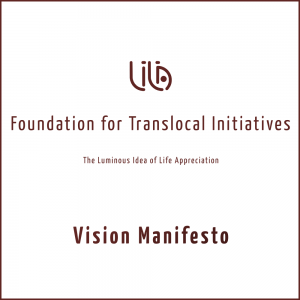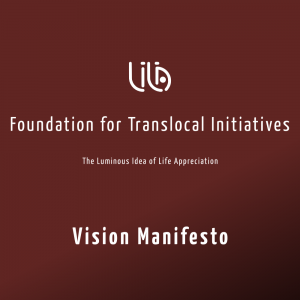
Vision Manifesto
The LILA Overture
Here it is. A new shape, a new face, a new colour, yet, the same play: the veritable lila.
It has been all around us, with us, within us, all the while. Lila has formed our elements and our senses since the beginning of time. Our matter in spirit and spirit in matter. The prana of creation. The origin and end of it all.
But, does it not point to another road, too? Beyond the illusion of origins and ends. To a miraculous set of solutions, always ready to take the problems of our world by surprise, by the tangent, by the alternative. That magic of intuition has been there, too, all along. Some have seen it. Inventors, artists, leaders – daring workers of the continuum of cultures – have discovered it time and again, calling it by various names. All their insights have contributed to the magnificent understanding of creation and re-creation as radically recreative. Lila : entering one’s inspired living in “a moment’s surrender, which an age of prudence can never retract.”
What happens after the lightning touches the skin of one’s eye? It blinds, indeed, but also wakens one’s pure pre-intellectual consciousness. It helps instantaneously deflate the many indulgent discourses of rationalism, utilitarianism, existentialism. Happiness, the primordial promise, suddenly appears on the line of horizon. The challenge of that liminal moment: to seize the flow, to be translocal, and move into a new vision, a new initiative. Creation-Re-creation-Recreation: to realise, to perpetuate the play, to find its new form, to find new forms for it. Distinctions blur.
Categories blur. Time blurs. Past and future now invite the same appreciation of life, to understand the dusks of the day before, and before; and the dawns of the day after, and after. And thus space blurs, too. Thus, behind the borders of geopolitics, also the borders of language, of customs and ethos, of histories, a continuous movement surfaces. Beyond the local, besides the global and well before the glocal, this humanity is always translocal, finding its ties only in the decentred matrix of a giant chakra.
What future are we inheriting? A lesson from time, a lesson on time and for time, first. A lesson about time. About all those time-bound, impatient temporalities that always risk burying the wealth of the past beneath undecipherable, light-less sea beds. Thus: the urgent patience of remembering, and time-connections before time-travels. Between the tragic solipsism of oblivion and the fearful attachment of preservation: conservation.
What is lila to rightfully expect of us? To help concretise the dreams of the millions, and to facilitate remembrance of the exploits of others. History and imagination are full of pathways, new ones, old ones, plenty directions, directives everywhere, to remember, to create, to re-create and celebrate. Lines doodle, shape up, surface at this horizon of lila that will always remain ahead as we engage its path. The dream inspires, the eyes open up once again; they provide lila with a shape. The most significant figure of the natural, the eternal horizon, it finally collides with culture, and places horizontal governance as our only plausible destination. From energy to creation to culture to polis. Aligning the hints of the cosmic play now, then back, and forth and back…: LILA.
❦
![]()
Vision Manifesto
Download the Vision Manifesto:
Yet, why does the human victory saga inadvertently reflect the built-in imbalances, the depreciated quality, of our societal life? Why does even a slight pause in the exaggerated rendering of this success story tend to scare us? Is it the possibility of encountering our own unhappiness that is frightening us? Is the melancholy of isolation that our linear pursuit of security has brought upon us, deterring us from slowing down on the fast track?
The idea of community as a variegated, yet organically evolving cultural experience of trust and happiness, has been rendered nearly obsolete by the highly self-referential success formulae of the times. Ironically, while our communication devices promise us inter-planetary connectivity, they have not been able to bring any peace to the warring nations of our world, or to bridge the ever-widening gaps between the haves and have-nots, or even to avert a petty neighbourhood skirmish. This line of thought brings us to the alarming realisation that it is at the dear cost of our simple everyday happiness that our societies have been privileging competitive performance over performative engagement, and prioritising networks for instant profit over relationships for life.
Can We Still Meet Our Happiness In a Community?
Is there a way out of this sad consequence to which our rather lonely contemporary existence has led us? Have we wandered too far into the labyrinth of indulgence, thus disabled to reclaim the happy sense of cultural continuity that a genuine community life alone can offer us?
Those were the questions that gave rise to LILA, the Luminous Idea of Life Appreciation. LILA envisages human happiness as emerging from an individual’s ability to find herself in a community where her dreams, emotions, thoughts, talents and actions are appreciated and aligned within a light and luminous continuum of creative engagement. LILA is thus the illumined vision of and practice for an individual living in close communion with her truest aspirations, her fellow beings, her cultural inheritances, her natural environment.
Towards realising LILA’s vision of happiness on the ground, and making it accessible to every human being, we at once play and institute LILA through a prism of transformation that we have brought into action:
PRISM
As a first step towards manifesting LILA, as ‘play’ and as ‘foundation’, we employ a multi-dynamic PRISM of transformation, which provides us with 5 key principles to engage with the creativity of the individual as well as the survival, the interactions, the ruptures, the revolutions and the splendid continuities of natural and civilisational phenomena: Performativity, Relevance, Innovation, Sustainability, Multiplicity.
It is significant for us that a prism allows horizontality as well as transparency. Our deconstructive enterprises are informed by the processes of prismatic refraction, reflection, deflection, polarisation, and dispersion. LILA understands the profound continuities of information, knowledge and wisdom revealed through numerous traditions of thinking, articulating and doing from across the world. LILA PRISM aspires to partake in this magnificent revelation through a certain discursiveness played into its flexible structure. Thus, even as it articulates the practical mode of LILA’s functioning, it bursts forth an exploration of the nature, colours and sensory modes associated with the pancha bhootas – the five elements – and their integral links with the chakras – the energy centres – in the moving human body.
The LILA PRISM dynamics works out through different phases and modes; it demonstrates LILA’s paradoxical determination to play and found itself as a lively space for thought, transformaction, and conservation, wherein its vital philosophy of humane translocality is constantly and most effectively realised.
Read each section by clicking on the respective title
 |
 |
 |
|||
 |
|||||
 |
|||||
 |
|||||
 |
|||||
 |

Lila signifies Play. The word holds rich resonances dating back to millennia. Multiple Indic philosophies have engaged with it to communicate their specific reflective directions and visions of life. For instance, in non-dualistic streams of thought, one finds lila often describing all experiential reality as the creative play of the Absolute. In dualistic systems, on the other hand, it frequently appears as the amorous or compassionate play of a personal god humouring his/her passionate devotees. Due to the wide range of associations scattered across scriptural, literary, graphic and performance texts from different periods, lila has gained multiple significations, especially in the Indian sub-continent.
Play, we appreciate, is the only act that allows us to be completely engaged, without feeling the burden of attachment. It awes us that play demands rigorous training, and yet opens the player to the ultimate possibility of adapting herself to the emergent movements on the ground. Therefore, we adopt the term lila to figuratively refer to the cadence of life’s spontaneous movements, the musicality of the continuous flow of living. But then, LILA, for us, is also a nuanced sense and practice of design and visualisation – the creative play of the versatile artist, the transformative act of enriching a word with layers of meaning, the re-creative faculty of the adaptable inventor; the light of faith in the eyes of the discoverer, the lightness in the heart of the appreciative beholder; the belief in happiness for all.
∾
The Play of Performativity:
Creation, Re-creation, Recreation
Creation as a never-ending process is the felt experience of every sentient being. It invokes the play of the universal in an individual. We see the dawn breaking out of the night’s gloom; the fallen fruits sprouting afresh; old businesses giving way to new ones; organisations and movements for peace taking shape through the course of wars. Philosophies and sciences have never ceased to speculate on and analyse the mysterious ways in which Creation plays itself out incessantly. At LILA, we appreciate the intuitive and creative faculties embedded in every adaptable being as the reflection and evidence of the eternal continuation of the cosmic energies into the vibrations of the material world. Here, origin paradoxically becomes continuity; energy becomes material. Hence, transformation through performativity becomes the key to our understanding of LILA as Creation, and the mode of our engagement with various actors and agents of change to facilitate various Re-creations across disciplines and cultural fields.
LILA also recognises that Recreation, is at the heart of the profound continuum of the individual’s creativity across her community’s transformation. This recognition has stemmed from the belief that happiness continuously evolves from a performative engagement with life and its circumstances, making ‘work’ not a laborious task for the individual, but an enjoyable play within a society. Such an enriching experience of recreation in the community opens an individual to the splendorous possibility of imagining and knowing her own life as a natural field delighting in the perpetual re-creation of the original cosmic movements. Hence, LILA at once becomes a site of Creation, Re-Creation and Recreation for its participants.
∾
The Play of Relevance:
Living and Sharing Luminosity
Leonard Cohen reminds us: “There is a crack in everything. That is how the light gets in.” And LILA adds: “And that is how the light gets out, too.” Light, with its simultaneous particle and wave nature, is for LILA a profound metaphor for the continuums of individual-community, event-history, matter-energy. For the same reason, we understand Luminosity as the ground and condition for ‘enlightenment’ through body, emotions, and intellect, which must lead us to a free spirit of lightness. It is the most important feature of an individual consciousness on its path towards Relevant transformations. Through the prism of one’s own luminosity, one not only perceives and actualises the beautifully refractive possibilities in transformation, but also communicates and shares it with the world around. Thus, we seek to manifest luminosity in the individual’s ability to provide a visionary direction for the society at large, and hence invoke the chances of the subjective being existing as a source of light in a given context, shaping the perceptiveness of all the participants therein. For the same reason, we fall back on nature to understand the true nature of this luminosity: light, at once as individual particle and as wave of energy; light, as capable of imparting warmth and evoking lightness; light, as a spectrum of colours of various frequencies and wave lengths; light, as a call to live in enlightenment; light, as the luminous idea of life appreciation.
∾
The Play of Innovation:
The Magic of Life Appreciation
LILA, through its multi-dynamic functioning, has evolved Life Appreciation as an inter-active process involving the Innovativeness of the individual vis-a-vis her past, present and future. It demands and engages with the intuitive, creative and intellectual faculties of the individual, and generates in her a magical sense of living. As a philosophical strain, it motivates every individual to live with a deep sense of gratitude to the many invisible forces – ideas, actions, inventions – that have facilitated her access to her current context and its rewards. Rather than choosing to follow the merely congratulatory association of appreciation, we locate the term within our nuanced acknowledgement of the human genius that imaginatively interconnects thoughts, experiences and expressions. This viewpoint has helped us work out an equitable methodology for society-building, wherein the creative co-existence of apparent opposites is made possible. Urging her to explore and act beyond the roles of a passive observer, critic or beneficiary, this process turns the individual into an active seeker, the creator of her own living. However, as she understands her life vis-a-vis the great march of humanity, she is saved the burden of attachment to both her knowledge and her contribution to society. This enables her to learn the secrets of the play of happy living – luminosity, lightness, surrender – even as she maintains vigil, rigour, perseverance and industry in her work.
Continuance on this luminous path of life appreciation opens a range of epistemic, transformative and conservational possibilities for the participant. It leads her to realise her own life as a shareable and interpretable resource— natural as well as cultural not only for the nourishment of her immediate context – but also as a reference for the world at large. Through these processes of seeking, learning, sharing, enriching, transforming, conserving and re-creating embedded in the principle of life appreciation, she transcends the limitations of her self and locale, and accesses her happiness in an intercultural continuum of community experience.
∾
The Play of Sustainability:
Life Nurturing Flow of Happiness
Happiness is when, what you think, what you say and what you do are in harmony
Mohandas Gandhi
The three fields Gandhi mentions in his definition of Happiness – thought, word, deed – can be in harmony only if these are employed in an environment that allows their seamless flow. Our social nature as human beings presupposes the stream of our happiness as springing from our access to an organic means of self-expression and livelihood in a healthy environment, an equitable habitat, and a democratic society. This flow of happiness must, in turn, sustain every human being through her various transformations and stages in life, and ensure, also, the growth and continuation of her community through time. Owing to this belief in the nourishing power of happiness, LILA has adopted the verse Happiness Sustains Life, a free translation of Anandena Jatani Jivanti, as its motto (Taittiriya Upanishad, Bhrigu Valli, Section 6, Verse 1:3). Happiness is indeed the prime sentiment at LILA.
This adoption/adaptation of happiness brings us to the play of language, of translation and transformation of words – the gift for communication unique to human beings. It at once opens many ways in which happiness can be translated into contemporary forms and expressions, as well as the possibilities of transforming different physical, emotional, epistemic and spiritual fields into playfields of happy enterprises. This involves the continuous discovery and rediscovery of the multiple possibilities of playing with words – coinages, investitures, ramifications, layering, reflections and reclamations, too – thus communicating LILA’s focus on transformativity.
An instance of our quest for enriching the word through rememberane and reclamation is found in our addressing every friend of LILA by the term Mitr. This is done as a counter act to the contemporary assumption that Mitr is a unique Sanskrit word. LILA finds creative ways to resist divisive attempts to monopolise words of common inheritance by using them with all their multi-dimensionality.
Mitr is a very ancient word, belonging to the Proto-Indo Iranian root, which preceded the separation of Indo-Aryan and Iranian language families. The word Mitr comes from the Avestan roots mei, “to bind” and tr, “that which causes”. A Mitr is thus one who causes a bond. Slowly, the word entered many different traditions: Mitra, the Rgvedic deity in Sanskrit, Mehr in today’s Persian, derivated from the ancient Zorastrian, Maitreya, the Bodhisattva showing the path to enlightenment in Buddhism, and also the Mithraic mysteries of Greco-Roman religion…
As this linguistic history shows, Mitr cuts across boundaries and cultures. It is a covenant, a promise that is kept across distances. And hence at LILA, we reclaim it from the clutched of hegemony, and use it across genders, languages and cultures.
∾
The Play of Multiplicity:
Energy for Manifest Initiatives
LILA is a Manifest site of Multiple Initiatives, each translocal in its implications, and interconnected with one another. It constantly finds ways to generate and conserve the energy required for its enterprises. LILA’s organic initiative has been an attempt to understand ‘culture’ as a continuum – culture as an extension of nature as well as a convergence of events, discoveries and discourses across time and space. Hence, the spirit of socio-cultural entrepreneurship tends to determine the direction of our initiatives. This leads LILA’s imaginative world to play with the range of creative possibilities emerging from the existential necessities of individuals. We are in agreement with Frank Lloyd Wright who says in The Future of Architecture, “Man has built most nobly when limitations were greatest, and therefore when imagination was required the greatest in order to build at all”. Human culture today has thus been built with the insights gathered through many civilisational journeys across great seas of trouble and scarcity. LILA’s initiative recognises the simultaneity of novelty and continuity, motivation and visualisation, initiation and persistence, drive and labour. It transcends the pain of labour in the certainty of fineness brought home by the presence of tasteful actors. Hence, enjoyment becomes the key to LILA’s initiatives, whose ultimate goals are self-development of the individual participants and, thereby, equitable governance in the society. The possibility of thus horizontally interlinking the vertical histories of individual ideas, actions and innovations in a multi-centred conservatory of human culture has prompted us to adopt the figure of the navagraha in the Indic cultural matrix as our principal source of inspiration. The insights derived therein are figuratively represented in the LILA Chakra, the model of the continuum of the Human Dream.
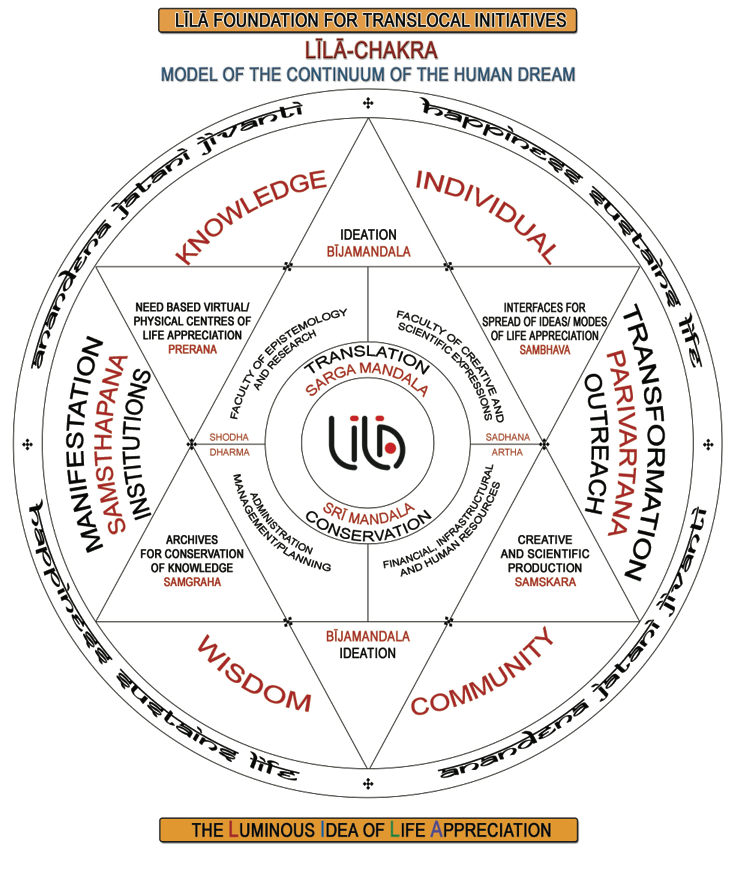
LILA’s vision, multi-dynamic as it is, finds expressions in various forms and modes of representation. The form of the tantric chakra used to graphically represent some of our foundational aspirations, is yet another example of LILA’s efforts at reclaiming/investing expressive forms and languages to equip them to carry myriad meanings. This, we attempt in order to liberate many forms and content categories, legacies for the humanity at large, from the one-to-one correspondence hegemonically imposed on them through various stages of history. Hence, the vision of LILA claims its multiple forms from various fields of expression – writing, graphic, performance, silence…

LILA is founded on the belief that happiness alone can sustain life. We are convinced that this happiness can be claimed only by, first, drawing from the strengths of one’s location, and, then, transcending its limitations and connecting with the world at large. As is evident in the LILA Chakra, we do not separate the mandalas of creativity (sarga) and governance (sri). LILA is a space that seeks and plays out the principle of abundance – the secret of making the enrichment of happiness accessible to the entire world through tangible as well as intangible resources. Towards the realisation of this vision as represented in the LILA Chakra, LILA proposes to create Sanctuaries of Life Appreciation in different locations, wherein the vision, mission, objectives of its Foundation would serve as the corner stone and building material.
 As we understand the relation between content and form, vision and material, as symbiotic, our logo expresses LILA’s ideals in its very graphic form. The logo, designed by cartoonist EP Unny and given form by calligrapher Narayana Bhattathiri, represents our desire to bend the vertical into the horizontal. We also wish to integrate all the elements valuable to us within the graphic expression, and without extraneous elements. The two red diacritical marks stand for our concern for working with individuals and singular communities, with care for their specificities. They contrast with the elongated black lines, representing our profound belief in continuums. The central dot of the letter A is a symbol of the inner energy, the initial spark that LILA recognises at the heart of every individual and community. Moreover, our environmental surrounding reveals the infinite curvatures of nature, a pattern LILA had to follow, in its spirit, and in its form – as a foundation, as a graphic representation.
As we understand the relation between content and form, vision and material, as symbiotic, our logo expresses LILA’s ideals in its very graphic form. The logo, designed by cartoonist EP Unny and given form by calligrapher Narayana Bhattathiri, represents our desire to bend the vertical into the horizontal. We also wish to integrate all the elements valuable to us within the graphic expression, and without extraneous elements. The two red diacritical marks stand for our concern for working with individuals and singular communities, with care for their specificities. They contrast with the elongated black lines, representing our profound belief in continuums. The central dot of the letter A is a symbol of the inner energy, the initial spark that LILA recognises at the heart of every individual and community. Moreover, our environmental surrounding reveals the infinite curvatures of nature, a pattern LILA had to follow, in its spirit, and in its form – as a foundation, as a graphic representation.
∾
A Performative Foundation
Playing Out Humane Translocality
LILA has been inspired by the possibility of organic transformation both at the individual and community levels, and this has led to the founding of the organisation: LILA Foundation for Translocal Initiatives. The ideological foundation of LILA is thus the notion of Humane Translocality, which allows crossing of one’s boundaries into a nuanced acknowledgement of the innumerable spatio-temporal and psycho-material aspects that contribute to an event in time. As a Foundation, LILA accepts this acknowledgement, this aptitude for Life Appreciation, as its operational principle. LILA considers Life Appreciation the core of transformativity, as it permits the transformation of an intangible concept or value into a tangible project or institution, and evokes all that it takes to found a space in an enduring manner – find, start, drive, conserve. Through the work of the Foundation, LILA rigorously develops an actionable as well as renewable strategy to make happiness a sustainable experience for all.
LILA’s philosophy of the Translocal draws from the firm belief that action towards creating an equitable society has to be rooted in an organic knowledge enterprise that first understands the strengths of the local/native, and then crosses its limitations to make renewable connections with the global/universal. LILA appreciates the intervention of cultural thinker Sadanand Menon that helped us realise the possibilities of the term Translocal.
As we see Life Appreciation as integral to Equitable Living, it becomes imperative for us to understand and actualise Happiness beyond the polarised notions of equality and inequality. Hence, in an effort to reclaim the original multicentricity of nature and the organic flow of human culture, LILA chooses to let go of the specific vantage points from where the artificial distinctions of global and local have lately been constructed. This demolition of perspective is not the end, but the beginning of our quest – a journey that surrenders to the lessons and rewards the road offers.
Privileging the journey over all destinations is the essence of LILA, for, it enables the traveller, the player, to be in touch with her natural human core. It sensitises the individual to her surroundings and fellow beings. A community of such Humane individuals alone can fairly appreciate the strengths and wants of their context, and move in enriching directions.
LILA has adopted Humane Translocality as its foundational principle and ideology, for, it resists and surmounts the taxonomical fixations of establishments through its perpetual call for Life Appreciation. As its unexpected imaginaries are meant to be revealed in the continuity of epochs, Time becomes LILA’s greatest ally. It thus exposes the fallacious pre-determination of the glocal stage shows – that briefly, but violently, yokes the convenient categories of global and local – and shows them as mere by-products of a fleeting moment of communication explosion.
Thus, on the ground, Humane Translocality presents a viable methodology for individuals and communities to function on their own transformative strengths at once within their natural ecosystems as well as transcending their civilisational heritage to overcome their weaknesses through constant learning. It is a call to humanity to evolve with dignity and live in happiness, undaunted by the neo-liberal advances on its spaces, times and ideals.
∾
A Relevant Foundation
Linking Nature and Culture
Before being an organisational collective, LILA becomes a creative connective born out of the conviction that the prospects of continuance of the natural world are profoundly interlinked with the cultural trajectories of the human race. This, we believe, has made our individual futures rely immensely on how we choose to play out our community Cultures with respect to the movements of Nature, and vice-versa.
LILA understands Culture as an offshoot of Nature, and not its antithesis, as it is generally perceived today. Consequentially, at LILA, our vision and practise of Culture bring forth a multi-centrered continuum of various ideas, experiences and expressions of humanity within the larger movements of the universe. We draw inspiration from the way Nature holds together its many-splendoured creatures and structures in a well-balanced eco-system. This would necessarily require a ramified appreciation of the term Cultural, the usage of which has over time been considerably narrowed down to signify only the artistic and ritualistic aspects of human societal functioning. LILA experiences and presents the Cultural as a pluralistic site enabling an intense awareness of the uninterrupted interconnectedness of beings, ideas, expressions, objects, places, functions and disciplines. Hence, our organisational mission is focussed on making this happy and continuous experience of intercultures available to every member of the apparently fragmented contemporary human society, as well as conserving the relevant shares of this experience for the wellbeing of all the elements of the universe.
∾
An Innovative Foundation
for Transformaction and Equity
LILA understands Transformativity as a constituent aspect of an individual or a community when it illustrates a capacity to incessantly act in a way that brings about an evident transformation in its functional life. LILA nurtures the faculty of Transformaction in its Foundation, through a continuous call for innovative thinking and creative expression extended to its members. We consider Transformativity as at once naturally infectious and acquirable through rigorous training. A transformative environment of ceaseless creativity spontaneously acts upon a passing object, and affects it with its transformativity. But this intimation of transformativity can take root and evolve only if it goes through specific drills and performances. Thus LILA as Foundation constantly innovates on its enterprise to create spaces that allow transformaction through the enigmatic simultaneity of individual intuition and societal preparation.
LILA understands innovative transformaction as playing a key role in facilitating equitable living in our times. Equity invokes and actualises the paradoxical twin principle embedded in every transformaction – belongingness-accountability. And, this double-edged term extends itself to embrace a few more dyads: justice-compassion, knowledge-enjoyment, rigour-spontaneity, tradition-modernity, community-individual, co-operation-freedom. The individual expressions in each of these dyads are not opposites, yet, they generate a certain tension when juxtaposed. LILA understands this creative tension as the fountainhead of equity, for, it helps one transcend the polarised history of justice engendered by the equal-unequal dialectic, and facilitates the creation of a multi-centred community experience inspired by the transitional processes of nature.
In this middle space, LILA’s seeking for a fair society is constantly taking shape. On this middle path of transformaction, we invoke and receive inspiration from various socio-political and philosophical traditions of the world. In other words, it is from our transit through the in-between that we draw our transformative energy to fulfil the ever-continuing enterprise of the Luminous Idea of Life Appreciation.
∾
A Sustainable Foundation
Building Conservatories of Life Appreciation
The three-fold work of LILA Foundation for Translocal Initiatives as an interdisciplinary think-tank, a transformaction platform, and a conservation laboratory, is an enterprise to actualise a horizontal continuum of the histories of ideas, actions and innovations that have understood human culture as a part of the unfolding of the grand design of nature. Hence, our practices of learning and action are aimed at conceptualising, designing and implementing a translocal programme to lead individuals and communities towards a profound appreciation of life based on the principles of nature.
In this effort the notion of Conservation plays a major role. LILA understands conservation as a process of nature. It allows time to mellow the universe, unlike the human-found process of preservation. LILA makes a distinction between conservation and preservation, as the latter places the human and its priorities in the centre of things. Preservation takes its directions from the human world and its comforts and pleasures to the exclusion of the larger ecosystem of which humans are only a part. So, there is a near desperate attempt to freeze processes and material in time, disallowing the natural progressions of survival, mellowing, withering, and rebirth.
LILA sees conservation as a process that aligns itself with the flow of life. Hence instead of preserving and museumising cultures, it proposes to facilitate conservation of cultures by investing in the continuity of their living traditions. In the process, the Foundation engages deeply with various locations to found conservatories that partake in their culturalities and help them evolve a methodology for continuance in the contemporary times. LILA’s vision and practice of archiving itself too is founded on this living model of conservation that allows withering as much as it facilitates renewals.
∾
A Multi-Centred Foundation
Proposing a Sutra of Governance
LILA acknowledges the creative tension between freedom and co-operation as a catalyst to the realisation of its life-project for Equity. Hence, we draw our inspiration for Governance from some seminal designs of Multicentred Unity and Humane Translocality from the Indic cultural matrix, the native site of LILA. The most important among these is the navagraha iconography wherein the nine planets of astrological import are represented in a way that allows them to retain their independence in terms of appearance, direction, and functions, even as they hold together as a multi-centred unity. One begins to understand the complex movements of the grahas only through circumambulation of the navagraha installation. By going around the multi-centred structure, one virtually partakes in the rotational and revolutionary movements of the planets, and experiences one’s own physical and spiritual movements as at once a part and result of cosmic vibrations. The navagraha iconography thus reveals to us the possibility of effecting happiness through the simultaneous actualisation of an individual’s freedom of choice and her co-operative movement within a community. Its abstractions of various worldviews inform us of the viability of developing an organic, multi-centred methodology of community building.
The navagraha figure also serves as a seminal sign pointing to the urgent need to set up an open conservatory of relevant thoughts, events and products that have marked the human race’s civilisational journey through millennia. LILA sees Conservation as a multicentred natural process, unlike the anthropocentric procedures of preservation and museumisation. Our methodology of archiving is closely modelled on conservation, because it does not impose either the parametres of human rationality or the insecurities of human psyche on nature’s incessant flow. Therefore, it makes no linear attempt to preserve any culture or tradition by freezing its movement and framing its organisational principles at a given time. Rather, our attempt is to organically develop open conservatories following nature’s logic of balancing the ecosystem through various transformative processes.
LILA’s emphasis on Multi-Centricity has led to a proposition to create a worldwide Governance connective enabling individuals and communities to spontaneously access their happiness by finding a sustainable means for equitable living. LILA Terra-Sutra understands the cultural as the most significant marker of the humanity’s civilisational shift towards settlement (becoming ‘urban’). In a creative response to the disastrous impact of the many mindless development narratives and city planning projects of our times, LILA Terra-Sutra proposes a mode of organic urbanisation:
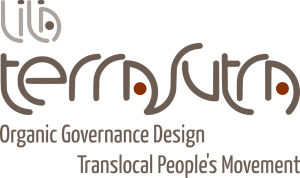
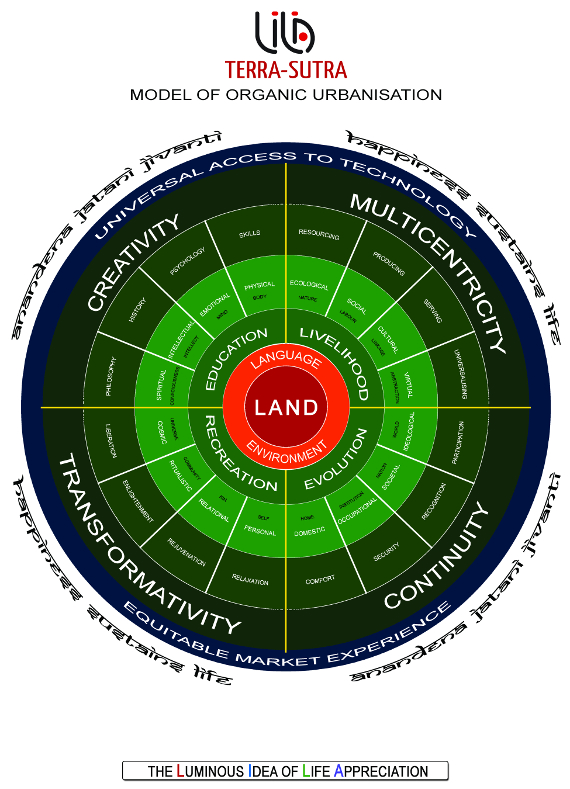
LILA Terra-Sutra invests itself in discovering, nurturing, celebrating, distributing, renewing and conserving resources in various fields of knowledge and creativity, so that the possibility of equitable and ecological living becomes apparent and integral to every human being. It understands Equity as the most effective means, the essential thread of connection, to creatively engage with the apparently uneven/unequal world. Towards this, it privileges the profound legacies of terra, earth, and sutra, thread. At its heart is the Land, which brings forth the significance of Language and Environment in the vision and practise of governance it proposes. We believe no society can arrive at a sustainable model of governance if it did not respect the material cultures of its communities as reflected in their centuries old local languages. And, no land can organically grow without giving serious attention to the environmental implications of the processes of development. Terra evokes the possibility of evolving urban spaces through a serious rethinking of the Language and Environment associated with a land, which are human civilisational interventions within nature’s eco-system.
Terra-Sutra is the thread that links the earth. The Pali Sutta Pitaka provides a set of fundamentals which LILA has adopted and adapted to form the basic Terra-Sutra tenets to create organic urban spaces of life appreciation: Faith/Belief (saddha), Energy/Perseverance (virya), Mindfulness/Memory (sati), Concentration/Focus (samadhi), Wisdom/Understanding (panna).
Through a multi-dynamic exploration of Transformation in the Buddhist text, LILA has extended the scope of its inspiration by connecting it with a number of like sites. Such resonances have encouraged us to re-view the Sutta Pitaka essentials through our own PRISM for Transformation: Sentiment for Performativity, Urge for Relevance, Thought for Innovation, Rigour for Sustainability, Awareness of life’s Multiplicity.
The LILA Terra-Sutra Chakra is a mathematical abstraction that contains within its use of primary colours, terms of reference, and geometrical segments, the immense possibility of opening out the ontological and phenomenological discourses embedded in the scheme of LILA PRISM. Through its very graphic structure, it pays respects to the many seeds of wisdom that humanity has discovered and nurtured over generations. LILA Terra-Sutra draws from the profound traditions of thus transferring many a nuanced experience of living from one space-time to another through a single representational image.
Through an Organic Cultural Design employing a few playsome turns of phrases, figures and colours, Terra-Sutra explores and rediscovers the cardinal terms and phenomenal principles that form the LILA PRISM – from cosmic performativity, through the quest of consciousness to be relevantly embodied in ideas, intellectual apprehension of innovativeness and governance, sustainability of the sentiment of happiness, to the physical realisation of multiplicity. It arrives at the possibility of refracting these principles through a prismatic experience of self-governance: a reverse play of faculties is found thus, moving from the physical performativity of the participants, through their emotional need to be relevant, their intellectual thinking towards innovation, their philosophical vision of justice, and ultimately to their inspirational realisation of the multiplicity of the universe.
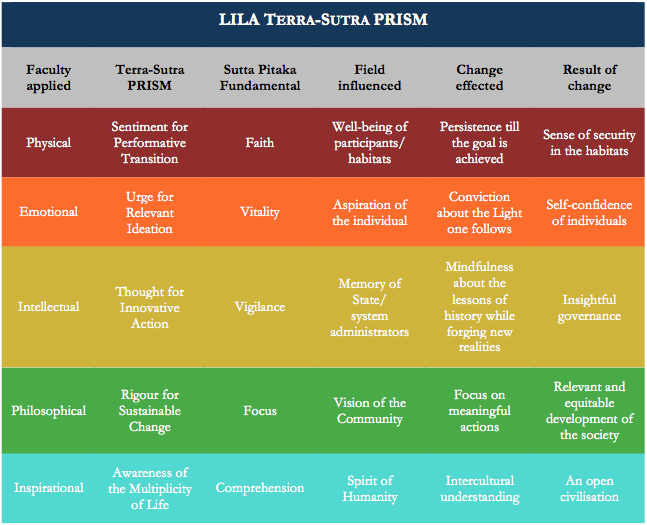 LILA Terra-Sutra endeavours to understand and recover Urbanisation in its etymological sense – as a process of Settlement presupposing a concern for a refinement of living. Today, urbanisation has come to be synonymous with mindlessness because, over time, the three characteristic features of urbanisation – culturing (Learning, Training and Resourcing), building (Production and Architecture), and sharing (Communications, Marketing and Distribution) – have come to be separated from the natural means of livelihood, sustenance and growth available to human communities settled in various parts of the planet. Terra-Sutra seeks to address this issue through the creation of a governance methodology for organic urbanisation that effects the gradual recovery of Human Refinement as an evolutionary process organically linked with the Human as a Natural Site. Under the Terra-Sutra umbrella, infrastructure, human and technological resources, knowledge and communication systems in various locales would be gathered into a Translocal Connective for Intercultural Equity facilitating a Horizontal Continuum of Happiness. The Terra-Sutra methodology takes into account the complexities involved in undertaking such a large-scale initiative in our multi-layered, acutely pluralistic world. Hence, it approaches the immense task at hand in a phased out manner, choosing to develop three sites manifesting the Luminous Idea of Life Appreciation in each phase, and gradually scaling up to create a world-wide connective.
LILA Terra-Sutra endeavours to understand and recover Urbanisation in its etymological sense – as a process of Settlement presupposing a concern for a refinement of living. Today, urbanisation has come to be synonymous with mindlessness because, over time, the three characteristic features of urbanisation – culturing (Learning, Training and Resourcing), building (Production and Architecture), and sharing (Communications, Marketing and Distribution) – have come to be separated from the natural means of livelihood, sustenance and growth available to human communities settled in various parts of the planet. Terra-Sutra seeks to address this issue through the creation of a governance methodology for organic urbanisation that effects the gradual recovery of Human Refinement as an evolutionary process organically linked with the Human as a Natural Site. Under the Terra-Sutra umbrella, infrastructure, human and technological resources, knowledge and communication systems in various locales would be gathered into a Translocal Connective for Intercultural Equity facilitating a Horizontal Continuum of Happiness. The Terra-Sutra methodology takes into account the complexities involved in undertaking such a large-scale initiative in our multi-layered, acutely pluralistic world. Hence, it approaches the immense task at hand in a phased out manner, choosing to develop three sites manifesting the Luminous Idea of Life Appreciation in each phase, and gradually scaling up to create a world-wide connective.
- LILA Terra-Sutra Sanctuaries of Life Appreciation
- LILA Terra-Sutra Campus-Links
- LILA Terra-Sutra Organic Cities
LILA Terra-Sutra Sanctuaries
of Life Appreciation
LILA Terra-Sutra will be worked out through a set of Sanctuaries of Life Appreciation set up in various countries across the world. The Sanctuaries in a particular country function as interconnected local hubs of creativity, making optimum use of the communication facilities provided by technology.
In India, Terra-Sutra will be operationalised through a regional wing called India-Sutra, which draws inspiration from the Humane Translocality in the Designs of a variety of remarkable Indic sites, such as Charles and Ray Eames’ ‘India Report’, the navagraha iconography, the initial materialisation of Shantiniketan, the structure of the Raga, Gandhi’s idea of Nai Talim… Thus would the Sanctuaries configure their processes of Abhyas (practice/training/ripening/preparation) for life appreciation in order to make Equity an accessible reality in our times.
LILA Terra-Sutra Campus Links
LILA Terra-Sutra Campus-Links is our effort to democratically link learning spaces across the world. The Sanctuaries become the organisational centres for the Campus-Links chapters in a locality. At LILA, we believe that Learning cannot happen through tabular organisations. Campuses should therefore be open spaces where learners could apply their knowledge in transformative ways, and become Change Agents. Derived from ‘camp’, a social field of learning, working and relating outside one’s home, we understand Campus as an extended site of learning. While it includes the conventional understanding of campus – through schools, colleges and universities – it also engages with all the meeting places of learners. Towards this, Campus-Links Chapters will be set up in diverse institutions and alternative spaces. These chapters would organise campus-based programmes to facilitate Intellectual Transformation, Opportunity Building and Social Responsibility among learners.
LILA Terra-Sutra Organic Cities
LILA Terra-Sutra has undertaken to ideate, research, and act on the City to rediscover Urbanity as a mode of happiness. This endeavour has resulted in the conceptualisation of the Terra-Sutra Organic Cities. On the ground, this movement would be actualised through a number of gradually evolving, creatively inter-connected Organic Cities privileging Life Appreciation.
If our urban governance does not find an organic way of transforming ‘rural’ communities into self-sustaining ‘urban’ communities realising their settlement, success and happiness in their own land, the governance of urban spaces will always remain an enigma. But this process of urbanisation cannot be done through a top to bottom approach, wherein outside ‘experts’ and ‘architects’ design the space and decide on the governance modalities. Hence, LILA Terra-Sutra has envisaged a model of urbanisation with three interconnected levels of organic evolution of spaces:
- Local: Knowing the land, its environment, its language/s
- Translocal: Realising the transformative potential of the local people, and thus connecting them with the universal
- Universal: Accessing the best rewards of human culture, and contributing to the greater common good towards happiness
The Terra-Sutra Sanctuaries and Campus-Links chapters would offer their resources towards the actualisation of the Terra-Sutra proposition of Organic Urbanisation and Governance, which necessitates the co-operation and coexistence of diverse cultures, even as each maintains its distinctive character.
❦
Coda
At LILA, we are convinced that in order to work out an inclusive yet rigorous strategy to build equitable communities in our times, we must find an effective way not only of nurturing the dreams, ideas, skills and energy of our young, but also of conserving various living-dying traditions and cultures, and making them relevant for our contemporary realities. It seems to us that our technologically determined society immediately requires humaneness foregrounding the ways of living as an art, and happiness as a way of living.
Towards initiating a translocal people’s connective to actualise this humaneness across the world in our times, and for the times beyond, we present this vision manifesto of the Luminous Idea of Life Appreciation.
❦
Objectives
 |
To conceptualise and set up virtual and physical centres, programmes and institutions in various areas of knowledge and action | |
| To collaborate with various actors engaged in the pursuit and spreading of knowledge without any distinction of caste, colour, race, creed or sex | ||
| To devise special programmes for individuals and communities underprivileged as a result of man-made and natural events | ||
| To design and promulgate both institutional and mobile programmes of public interface binding ideas and actual effects | ||
| To provide aid to any individual, organisation or institution from across the world, which shares our vision of transformation |
| To invoke the human ability to interlink in our divided times, by triggering the associative consciousness latent in every individual |  |
|
| To work with the humanities, social and natural sciences to vitally link with the needs of the learners, society and the environment at large, in order to promote socio-environmental practices within the academy | ||
| To actualise a horizontal educational continuum wherein the participants understand one another as peers in cultural exploration |
 |
To extend the natural law of symbiosis into academic and creative practices to align individual pursuits with the true wellbeing of their society, times, body, mind and spirit | |
| To rely upon the telling, retelling, interpreting and adapting of narratives to express a freedom to understand and creatively re-imagine the conditions at hand, as in the tradition of the Gurukulam | ||
| To confirm happiness as the destination of all epistemic and creative endeavours through the facilitation of a dynamic enterprise of translocal knowledge |
| To imagine and actualise the overall vision of LILA, in order to reignite enthusiasm to partake in the collective enterprise of human empowerment and creativity |  |
|
| To further the awareness of human continuity through ages, by opening ourselves to the humble realisation that many had dreamt this dream before us, many do along with us, and many will, after us | ||
| To facilitate the re-connection of human beings with their inner springs of happiness, thereby resisting the distancing habits of contemporary life |
lilafoundation.in
lila@lilafoundation.in
© LILA Foundation for Translocal Initiatives 2015






